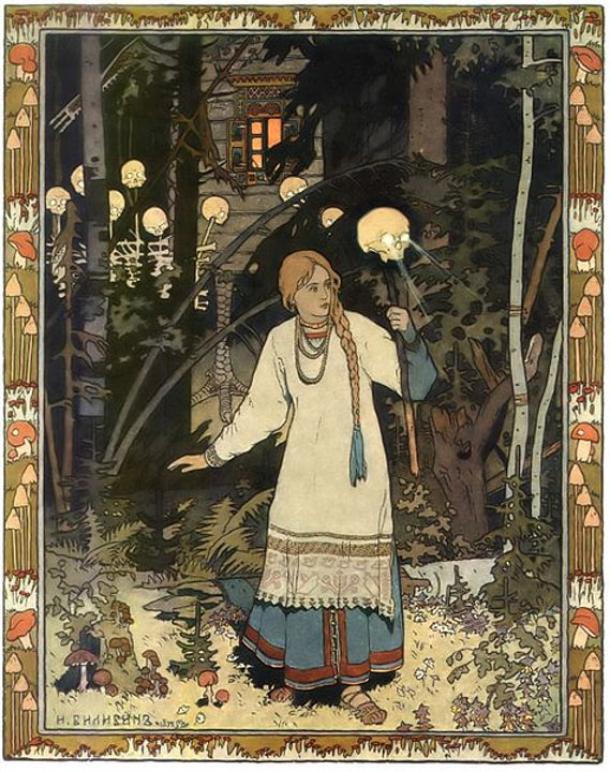In which we enter the world of Russian folklore and ask impertinent and possibly irrelevant questions about a soup called Solyanka. Vasilissa the Fair is a Russian wonder tale, as collected by Alexander Afanasief. In this unusual story, the heroine comes up against not only the traditional wicked stepmother and envious stepsisters but also a dangerous Baba Yaga.
In which we enter the world of Russian folklore and ask impertinent and possibly irrelevant questions about a soup called Solyanka. Vasilissa the Fair is a Russian wonder tale, as collected by Alexander Afanasief. In this unusual story, the heroine comes up against not only the traditional wicked stepmother and envious stepsisters but also a dangerous Baba Yaga.
We also talk about what happens to those who don’t share their food and how sometimes home is scarier than the hut of a child-eating witch/pagan goddess of the earth/nature spirit.
This week’s recipe is for Solyanka, a historic Russian (possibly Ukrainian) dish. Solyanka is a wonderful salty, sour soup or stew. The rich melting beef, smoky sausages and the unami from the mushrooms is enhanced by the saltiness and sourness of the preserved vegetables and olives. The tomatoes and prunes disappear into the sauce to provide a touch of sweetness that complements the whole dish. If you’d like to cook a vegan/vegetarian version there are some excellent recipes online with cabbage and an unami mushroom hit.
If you want to know more about it’s history and some further reading on either the recipe, Vasilissa the Fair or Baba Yaga please visit www.hestiaskitchen.co.uk
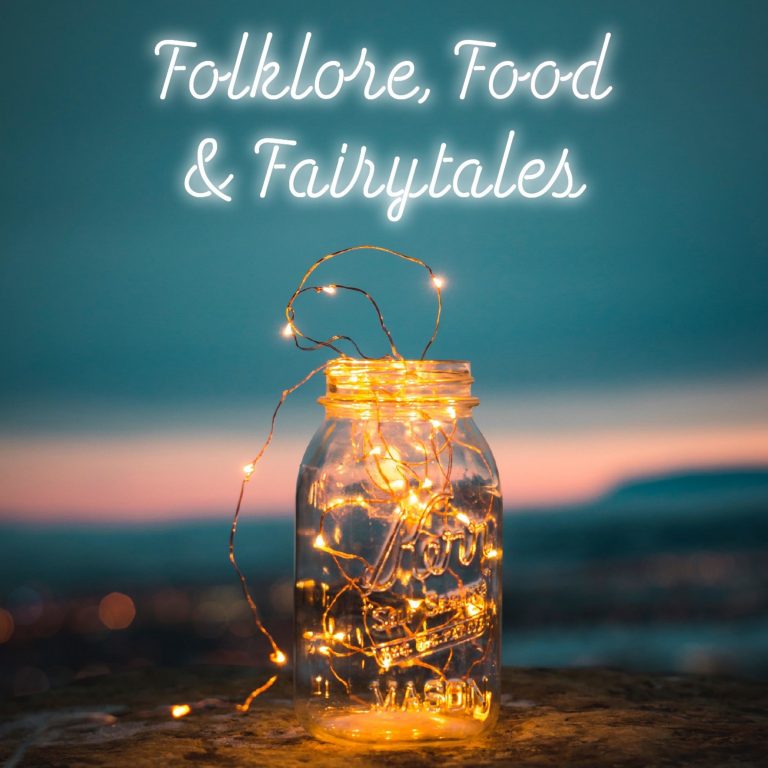
Who or what is a Baba Yaga?
Baba Yaga, a famous supernatural being of Slavic folklore is a fascinating character. She appears in many stories and no Baba Yaga is exactly the same as another. This nature spirit is often ambiguous, sometimes helpful, more often not. She is sometimes even plural (three sisters). Every story contains a different Baba Yaga. She has also been known to eat people, often children (this is where we stretch the definition of ambiguous).
Baba Yaga often appears as a pagan goddess of the woods, associated with death and the harvest. She always has store cupboards filled to the brim with grain and wheat and lots of preserved meat.
The incredibly cold and hard winters of Russia ensured many of the original listeners to these tales would have understood that these stores meant the difference between life or death.
The Soup (definitely child-free)
In this story food, or lack of it plays a large part both in Vasalissa’s home and in the hut in the woods. I discuss what that means from the perspective of the story in the podcast. It is befitting the story that this week’s recipe is inspired by the foods in Baba Yaga’s well stocked hut rather than in Vasalissa’s unhappy home. Baba Yaga dines plentifully on soup and meats amongst other rich, filling foods.
There are several traditional soups that this could be but Solyanka seems a good fit with its use of smoked meats and preserved vegetables. Solyanka is a salty, sour, spicy soup first mentioned in 15th Century Russian texts. It has now spread across Russia and former eastern bloc countries in many variations. There is much argument about its origins as many other sources have it as dating from 17th century Ukraine.
The source of the name is also a point of contention: many sources believe it comes from the Russian word for salt. However, others feel that it originates from the Russian word for female villager and could just as easily be translated as village soup or peasant soup.
Solyanka – A soup trilogy
The confusion probably comes from the fact that historically there were at least three types of Solyanka, one based on meat, one on mushrooms and cabbage and one on fish. The saltiness and sourness originally came from the salted preserved vegetables that were used in all the varieties as fresh vegetables were almost impossible to come by in the hard northern winters.
There are thousands of variations of this soup including in two of my favourite recipe books: Mamushka, Recipes from Ukraine & Beyond by Olia Hercules and Kachka, A Return to Russian cooking by Bonnie Frumkin Morales. These are both definitely soup recipes with wonderful stock bases and preserved meats and vegetables but they are still very different.
Are we sure it isn’t a stew?
I however came across Solyanka in quite a different format, much more like a stew but with similar salty, sour ingredients. My first taste of Solyanka was on a freezing night in a Lithuanian restaurant, accompanied by vast amounts of caraway rye bread and strong, dark beer. Sadly the restaurant has since closed down, but I have been left with wonderful memories.
I had to find a way to make it at home from taste memory. Starting with about 10 recipes and picking out what seemed to be familiar flavours I developed the recipe below. It is inauthentic but eating it takes me back to that memorable evening and is as close as I can get.
Some Vague Disclaimers
However be warned, this is extremely rich and filling and there is a lot of it. If you make the full recipe make sure you have a big pan and I would either have a few people to feed or freezer space available. It does freeze beautifully and like any other stew, benefits greatly from an overnight rest in the fridge. I’m lucky enough to have several excellent Eastern European food shops nearby which provided me with excellent smoked sausages, gherkins, preserved mushrooms and sauerkraut. However, you can probably get them in the specialist food aisle in the supermarket.
Solyanka
8-10
servings40
minutes3
hoursSolyanka is a wonderful salty, sour soup. The rich melting beef, smoky sausages and the unami from the mushrooms is enhanced by the saltiness and sourness of the preserved vegetables and olives. The tomatoes and prunes disappear into the sauce to provide a touch of sweetness that complements the whole dish.
Ingredients
50g dried porcini or mixed mushrooms
250ml hot water
1 tbsp butter
1 onion, chopped
2 cloves garlic, minced
1 large carrot, sliced
1.5kg stewing beef, cut into roughly 1 inch square chunks
4 smoked sausages/Polish kilebasa cut into rounds about as thick as £1 coin
100 g smoked bacon lardons
2 big gherkins (in brine not vinegar), chopped
1 jar marinated mushrooms
15 Kalamata olives, pitted
2 bay leaves
½ tsp ground black pepper
2 tins chopped tomatoes
2 tbsp tomato puree
1 tsp sweet paprika, smoked
6 baby potatoes, halved
250g dried prunes
1/2 jar sauerkraut
Soured cream/lemon halves (optional)
Directions
- Soak dried mushrooms in the hot water and set aside to soften for 30 minutes, then remove mushrooms from water while and strain the liquid through a fine sieve, set aside for later use.
- In a large cast iron pot fry bacon lardons until they render fat, remove to a separate plate. To the same pot add stewing beef and brown on high heat with a pinch of salt and freshly ground pepper, remove to the same plate as bacon, then add sliced smoked sausage and brown briefly, remove to the same plate as beef and bacon.
- To the now empty pot add butter to melt then add chopped onion and sauté on medium heat for 5 minutes, add carrot and garlic and continue sautéing for 5 more minutes. Add marinated mushrooms, pickles, olives and rehydrated mushrooms and paprika, cook while stirring for 5 minutes.
- Return beef, bacon and smoked sausage to the pot, add 2 bay leaves, the liquid mushrooms were soaked in, tinned tomatoes and up to a 1l of water depending on your pan size, bring to a boil and then turn the heat down to low.
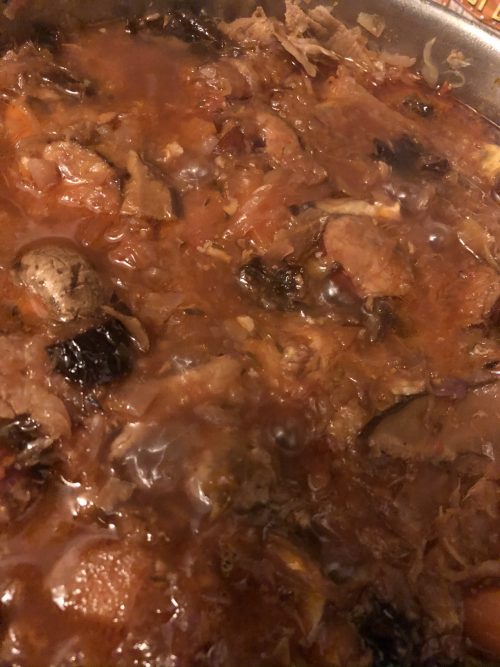
- Simmer for 2 1/2 -3 hours, checking on tenderness of beef as a clue to cooking time. 30 minutes before the time is up add halved baby potatoes and sauerkraut.
- Check your stew once in a while, stir to avoid burning. By the end of the cooking time it should be thick and the beef should be very tender. Add chopped herbs at the end and check for seasoning.
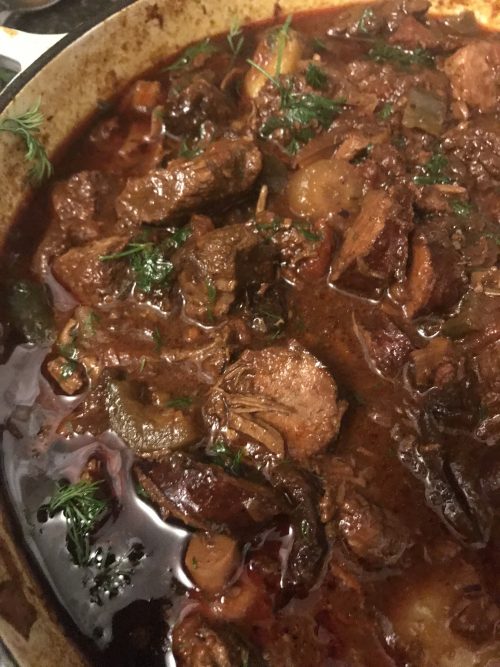
- Serve with sour cream or creme fraiche and slices of lemon if desired.
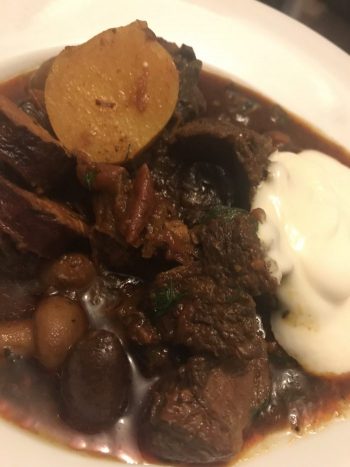
Notes
- This feeds a lot of people. Those are hungry people servings especially if you have plenty of bread to go with it.
- This recipe is perfect for freezing and event benefits from an overnight rest in the fridge
Further Reading
To find out more about Solyanka I can suggest the following:
Mamushka, Recipes from Ukraine & Beyond by Olia Hercules
Kachka, A Return to Russian cooking by Bonnie Frumkin Morales
CCCP Cookbook: True Stories of Soviet Cuisine, Olga & Pavel Syutkin
Book of Tasty and Healthy Food: Iconic Cookbook of the Soviet Union
The Soviet Diet Cookbook by Anna Kharzeeva
If you have a local independent bookshop I’m sure they would be happy to order these for you. If you have a local library, they might also be able to order them.
https://folkways.today/solyanka-sour-russian-meaty-soup/
https://bridgetomoscow.com/solyanka
I suggest the following to find Vasilissa the Fair, other Russian folktales and more about Baba Yaga
Folk Tales from the Russian Kalamatiano De Blumenthal
Russian Folk-Tales, by A. N., (Aleksandr Nikolaevich), (1826-1871) Afanasev
Russian Fairy Tales, A Choice Collection of Muscovite Folk-lore – W. R. S. Ralston
BABA YAGA – The Wild Witch of the East in Russian Fairy Tales – Forrester, Sibelan; Goscilo, Helena; Skoro, Martin
Baba Yaga: The Ambiguous Mother and Witch of the Russian Folktale. – Andreas Johns
Women Who Run with the Wolves: Myths and Stories of the Wild Woman Archetype. – Clarissa Pinkola Estés
The first three books are in the public domain and you can download them from Gutenberg for free. The others are more pricey but you might be able to track them down second hand or through the library. Alternatively, talk to your local independent bookshop.
If you would like hear me tell the story, please listen to my podcast below. There is more information on my about me page if you’d like some further reading.

